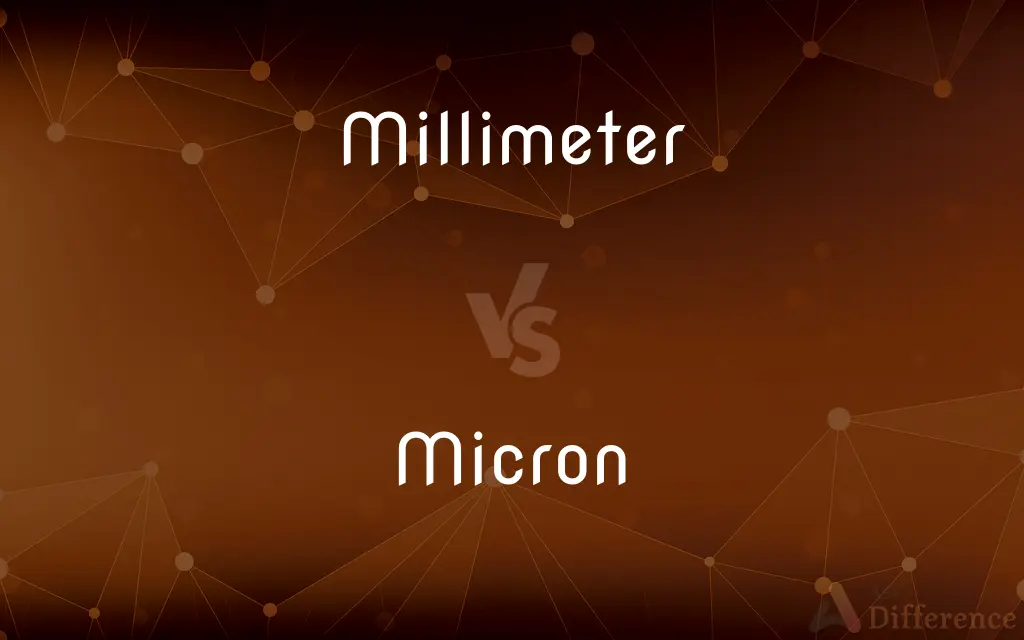Millimeter vs. Micron — What's the Difference?
By Tayyaba Rehman & Urooj Arif — Updated on April 21, 2024
A millimeter is a unit of length in the metric system equal to one thousandth of a meter, whereas a micron, or micrometer, is one thousand times smaller, equal to one millionth of a meter.

Difference Between Millimeter and Micron
Table of Contents
ADVERTISEMENT
Key Differences
A millimeter (mm) is commonly used to measure small but visible distances, such as the thickness of a pencil. On the other hand, a micron (µm), also known as a micrometer, measures even smaller dimensions, typically used in microscopy or technology manufacturing.
When discussing manufacturing precision, millimeters might be sufficient for general parts, whereas microns are crucial for semiconductor and optical components, where microscopic precision is essential.
In scientific research, measurements might switch from millimeters to microns when detailing extremely small scale phenomena, such as the size of bacteria or particles in materials science.
The tools used for measuring in millimeters, such as rulers and calipers, are common and easy to handle, while measuring in microns often requires specialized instruments like micrometers or electron microscopes.
While both millimeters and microns are units derived from the metric system base unit of meters, the micron is more specialized and indicative of high-precision engineering and scientific research contexts.
ADVERTISEMENT
Comparison Chart
Length
0.001 meters (10⁻³ meters)
0.000001 meters (10⁻⁶ meters)
Usage
General small measurements
Precision engineering, science
Measurement Tools
Ruler, calipers
Micrometer, electron microscope
Visibility
Visible to the naked eye
Requires magnification
Common Application
Jewelry, engineering, construction
Microelectronics, biology
Compare with Definitions
Millimeter
A unit of length in the metric system equal to one thousandth of a meter.
The thickness of the book was about 30 millimeters.
Micron
Vital in optics for measuring wavelengths of light.
UV light has wavelengths ranging from 10 to 400 microns.
Millimeter
Standard unit for measuring the diameter of small circular objects.
The diameter of the coin was 25 millimeters.
Micron
A micrometer, one millionth of a meter, used in scientific and technical fields.
The new microscope can detect particles as small as 2 microns.
Millimeter
Used in meteorology to measure precipitation levels.
The rainfall was recorded at 5 millimeters yesterday.
Micron
Used to measure cell sizes in biology and material grains in materials science.
Human red blood cells typically measure about 5 microns in diameter.
Millimeter
Used in everyday measurements where precision beyond the centimeter is required.
They measured the dimensions of the table in millimeters for accuracy.
Micron
Often used in air quality measurements to specify particle sizes.
HEPA filters can trap particles as small as 0.3 microns.
Millimeter
Common in engineering drawings to specify the dimensions of parts.
The new design specifies a bolt length of 15 millimeters.
Micron
Crucial in fields requiring ultra-precision like semiconductor manufacturing.
The circuit features were etched with a precision of 10 microns.
Millimeter
A unit of length equal to one thousandth (10-3) of a meter, or 0.0394 inch. See Table at measurement.
Micron
A unit of length equal to one millionth of a metre, used in many technological and scientific fields.
Millimeter
Alternative spelling of millimetre
Micron
A unit of length equal to one thousandth (10-3) of a millimeter or one millionth (10-6) of a meter. Also called micrometer.
Millimeter
A lineal measure in the metric system, containing the thousandth part of a meter; equal to .03937 of an inch. See 3d Meter.
Micron
(physics) The thousandth part of one millimeter; the millionth part of a meter.
Millimeter
A metric unit of length equal to one thousandth of a meter
Micron
(figurative) A very tiny amount.
Micron
(linguistics) breve
Micron
A measure of length; the thousandth part of one millimeter; the millionth part of a meter.
Micron
A metric unit of length equal to one millionth of a meter
Common Curiosities
Can I see a micron with the naked eye?
No, microns are too small to be seen without magnification.
What tools are used to measure in microns?
Tools like micrometers and electron microscopes.
What industries use microns for measurement?
Semiconductor, biology, and air quality control industries.
What is more precise, a millimeter or a micron?
A micron is more precise, being 1,000 times smaller than a millimeter.
Is there a conversion tool for millimeters to microns?
Yes, multiplying millimeters by 1,000 converts them to microns.
How are wavelengths of light measured?
In microns, particularly for infrared and ultraviolet light.
What might require measurement in microns in everyday life?
Pollen size, dust particles, and bacteria dimensions.
Why would someone use microns instead of millimeters?
For high-precision measurements in science and technology.
What are common applications for using millimeters?
Engineering, construction, and meteorology.
How do millimeters and microns relate to the meter?
A millimeter is one thousandth of a meter, and a micron is one millionth of a meter.
How does precision in measurements affect technology?
Greater precision can significantly enhance the performance and miniaturization of technology.
Are micrometer and micron the same?
Yes, a micrometer is another term for micron.
What is the smallest size visible to the human eye?
Typically about 40 microns under good lighting conditions.
Which unit is more commonly used in medical fields?
Microns, for detailing cell sizes and microorganisms.
What is the importance of measuring precipitation in millimeters?
It helps in accurately assessing rainfall for weather predictions and agriculture.
Share Your Discovery

Previous Comparison
Typhoon vs. Monsoon
Next Comparison
Carabiner vs. CarabineerAuthor Spotlight
Written by
Tayyaba RehmanTayyaba Rehman is a distinguished writer, currently serving as a primary contributor to askdifference.com. As a researcher in semantics and etymology, Tayyaba's passion for the complexity of languages and their distinctions has found a perfect home on the platform. Tayyaba delves into the intricacies of language, distinguishing between commonly confused words and phrases, thereby providing clarity for readers worldwide.
Co-written by
Urooj ArifUrooj is a skilled content writer at Ask Difference, known for her exceptional ability to simplify complex topics into engaging and informative content. With a passion for research and a flair for clear, concise writing, she consistently delivers articles that resonate with our diverse audience.
















































